#arctic woolly bear
Note
hiiii love this blog have you done the arctic woolly bear moth :^)
Moth Of The Day #276
Artcic Woolly Bear Moth
Gynaephora groenlandica
From the erebidae family. They can be found in Canada, Greenland and Wrangel Island.
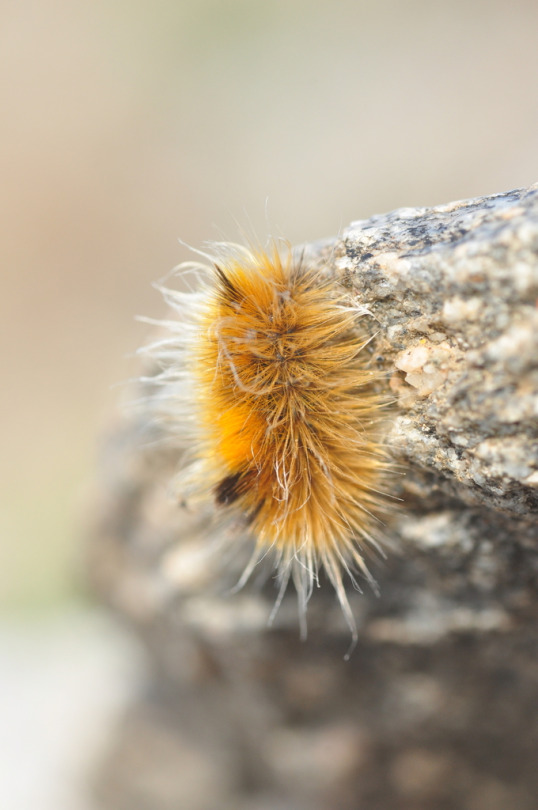

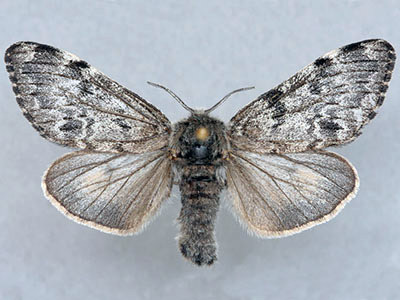
Image sources: [1] [2] [3]
#moth#moths#lepidopterology#lepidoptera#nature#pretty moth#bugs#insect#moth of the day#motd#lepidoptery#entomology#bugblr#bug#insects#caterpillars#caterpillar#arctic woolly bear moth#arctic woolly bear#gynaephora groenlandica#erebidae#erebidae moth
171 notes
·
View notes
Text
Animal of the Day!
Arctic Woolly Bear (Gynaephora groenlandica)
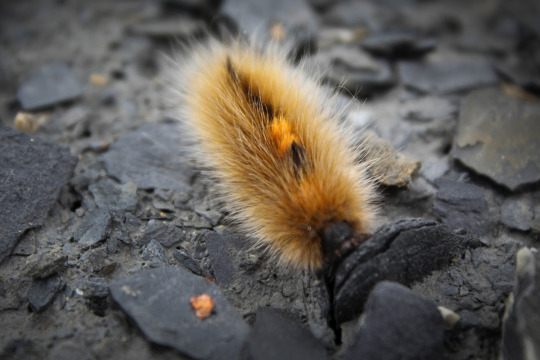
(Photo by Vasika Undurawane)
Conservation Status- Unlisted
Habitat- Northern Canada; Greenland; Wrangel Island
Size (Weight/Length)- 70 mm
Diet- Leaves
Cool Facts- You might be surprised to hear that insects are able to thrive in environments that dip below -70 Celsius. The arctic woolly bear is a tiny moth that has mastered the freezing cold. These caterpillars live their life in constant motion as the growing season, when food is available, is only a maximum of 70 days. The caterpillars switch between feasting on leaves and basking in the sun, doing their best to grow in a race against the clock. When leaves start to shrivel and the snow returns, the arctic woolly bear weaves itself a silken blanket and shelters under the snow, essentially freezing itself solid. After a total of seven years, amounting to only 490 days outside of diapause, the arctic woolly bear cocoons and bursts out as a moth. For a period of 3-4 weeks, the moth flutters around to breed and lay eggs before passing away and the cycle continues through their offspring.
Rating- 12/10 (Spends only 6% of its life as an adult.)
#animal of the day#animals#insects#caterpillar#moth#woolly bear#tuesday#december 26#arctic woolly bear#biology#science#conservation#the more you know#cw: insects
123 notes
·
View notes
Text
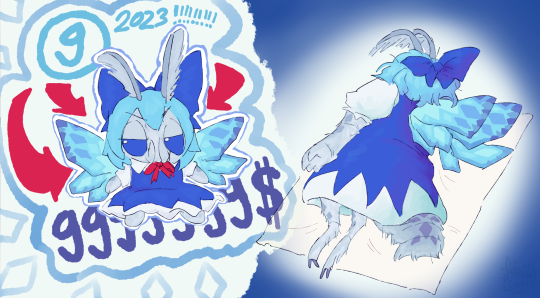
cino day
#fig.1 moth cirno fumo#fig.2 fanart i drew of moth cirno dying in a glue trap#shes an arctic woolly bear moth :) but plume moths have weird wings that look more like her og 3 ice spike wings#my art#touhou#cirno#anthro#furry
23 notes
·
View notes
Photo

Arctic Woolly Bear Moth (Gynaephora groenlandica)
Family: Underwing Family (Erebidae)
IUCN Conservation Status: Unassessed
One of only a small number of insect species found within the Arctic Circle, the Arctic Woolly Bear Moth is notable for the extremely slow rate at which it develops: caterpillars of this species (which can be identified thanks to their large size and extremely thick black-and-orange hair) may take as long as seven years to develop into adults, and regularly delay their development in order to enter a hibernation-like state in a sheltered area in order to survive the brutal arctic winter. Native to arctic regions of Canada, Greenland and Wrangle Island (a large island off the northern coast of Russia), Arctic Woolly Bear Moth caterpillars live on the ground and are active for only a short period during the summer during which they slowly crawl between low-growing plants (primarily the Arctic Willow) on which they feed before seeking out a sheltered area (such as beneath a rock), securing themselves to a solid surface, constructing a shelter out of silk and entering a dormant state until the following summer - even when awake they are sluggish and slow-moving, and spend most of their time outside of hibernation sunbathing in order to keep themselves warm enough to continue searching for food. After several years spent largely in hibernation with only occasional month-long periods of activity, mature caterpillars of this species finally undergo pupation and emerge shortly afterward as large, grey, woolly-looking moths that may mate within as little as 24 hours of emerging from their chrysalis. As flight is difficult and dangerous in windier regions of the Arctic female Arctic Woolly Bear Moths rarely fly far from the site at which they underwent pupation, instead releasing strong-smelling chemicals that encourage males to fly to them. The eggs of this species are typically laid around the remains of their mother’s cocoon, and adults of both sexes pass away before the end of the summer in which they reach adulthood.
--------------------------------------------------------------------------
Animal Advent Calendar - Day 13
Image Source: https://www.inaturalist.org/taxa/452615-Gynaephora-groenlandica
#December 13th#Antarctic woolly bear moth#moth#woolly bear moths#moths#tw moth#tw moths#insect#insects#tw insect#tw insects#entomology#zoology#biology#animal#animals#wildlife#north american wildlife#asian wildlife#arctic wildlife
32 notes
·
View notes
Text
Moth of the Week
Isabella Tiger Moth
Pyrrharctia isabella

The isabella tiger moth is part of the Erebidae family and was first officially named in 1797 by James Edward Smith. The caterpillars of this moth are referred to as woolly worms, woolly bears, and banded woolly bears. In Canadian folklore, these caterpillars serve as predictors of harsh or east winters depending on their hair’s length and color.
Description The isabella tiger moth’s body and wings range from tan to yellow-orange. The hindwings are a lighter shade than the forewings with both marked by black spots and faint lines. In females, the hindwings have a pink tone. The body also has a black spotted pattern with reddish-orange forelegs. The moth’s color darkens at the head to a red-orange or brown.
Average wingspan of ≈4.35 cm (≈1.7 in)
Diet and Habitat The caterpillars eat many plants and trees such as grasses, asters, birches, clover, corn, elms, maples, milkweed and sunflowers in deciduous woodlands and prairies. Adults drink nectar from host plants. They use a proboscis, which is like a feeding tube. These moths are found in all of the United States except for the states of Alaska and Hawaii, much of Mexico, and southern Canada. The isabella tiger moth also can be found in the Arctic.
Mating The isabella tiger moth produces two generations a year in its northern range and usually a three generations in the south. In May during the evening, females let out pheromones from a scent gland from their abdomen to attract mates. Males fly in zig-zag patterns and mate with the females. Females lay clusters of 50 or more eggs on the host plants. The eggs will hatch in 5 to 12 days. The eggs hatched in the fall will give way to caterpillars that will freeze in the winter, thaw in spring, and continue the cycle.
Predators Woolly bears will curl into a ball if feeling threatened. The stiff hairs protect the caterpillar from wasps, flies, mantids, birds, and other predators, such as humans. Touching a woolly bear is discouraged because these hairs may cause dermatitis, however they are not venomous and typically don’t cause irritation.
Fun Fact Woollybear festivals are held in several locations in the fall with games, costumes, and a winter prediction.
(Source: Wikipedia, Moth Identification, BugGuide, Minnesota Seasons, iNaturalist, Iron Tree Service, Wildlife in Winter)
#animals#bugs#facts#insects#libraryofmoths#moth#mothoftheweek#lepidoptera#Erebidae#isabella tiger moth#Pyrrharctia isabella
34 notes
·
View notes
Text

In celebration of finally posting my own art after months, I'm posting all of my Kirby OCs so far!! My attempt at making individuals (and info about each) under the cut!! (None of them have color yet, sadly)
I think you should bw able to submit asks to me for them 👍👍
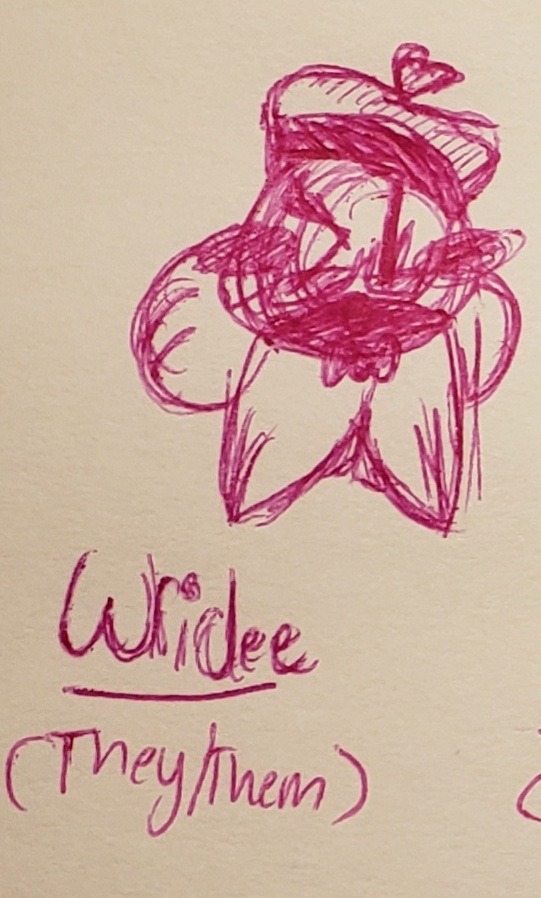
Writer Waddle Dee (Wridee)
•They/Them, but doesn't mind She/Her or He/Him
•Most info you can find on their submission for the Kirby OC Tournament

Jagger
•He/They
•Mmmmm, evil little michevious fella
•Based on the Long-Eared Jerboa
•Ears are so floppy and big that he can use them to ascend
•Tail is considerably strong- smacks stuff around with it

Lepidra
•She/They
•Based on the Rosy Maple Moth
•Oldest OC actually :D not by actual age lol, but she was the first one I created!
•Floralian doctor
•Mute because no mouth

Loyal Knight (Name in development)
•She/Her
•Hero of Soul posing as a simple civilian for lore reasons
•Little cape is actually wings- specifically the arctic woolly bear moth's wings
•Uses a bow that can transform into sword (Whole reason why I made her lol)
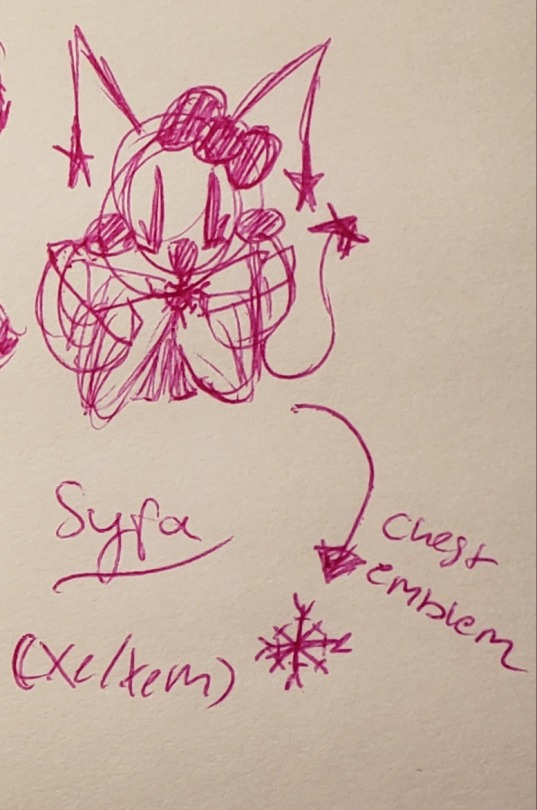
Syra (Name in development)
•Xe/Xem
•A lot like Kirby, I'd say, might change in the future though
•I literally just created xem today, xe basically have no lore right now
#kirby oc#writer waddle dee#wridee#Jagger#Lepidra#Loyal Knight#Syra#<<Both names are in development rn#ozzy's little sketches
3 notes
·
View notes
Text
October 19th, 2023
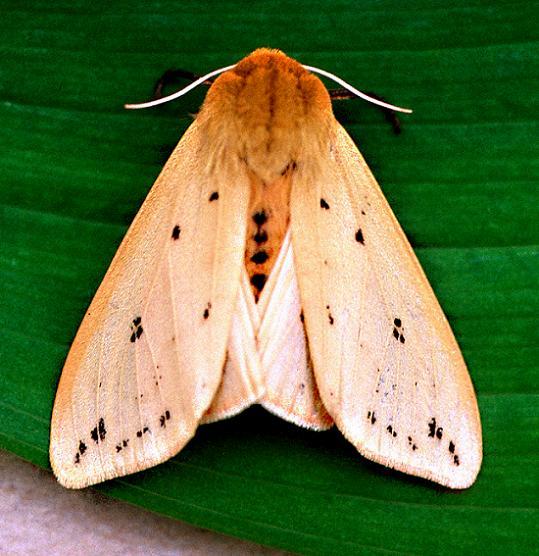
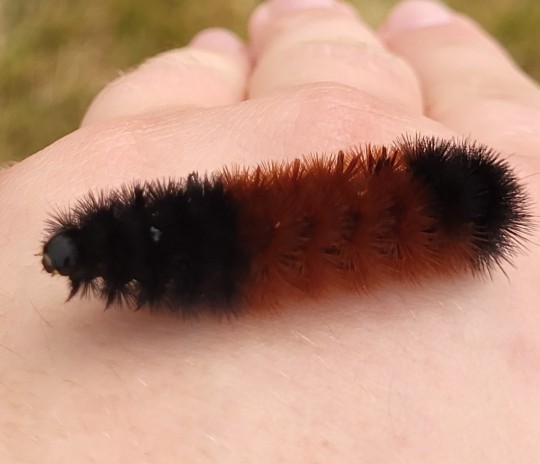
Isabella Tiger Moth (Pyrrharctia isabella)
Class: Insecta
Distribution: Found throughout the United States, Mexico and southern Canada.
Habitat: Usually found in open, dry to slightly moist habitats, such as weedy fields, fallow cropfields, roadsides and occasionally forested areas.
Diet: Generalists; Caterpillars are minor defoliators which feed on the leaves of aster, birch, clover, corn, elm, maple, sunflower, as well as grasses and weeds such as dandelion, plantain and nettle. Adults drink wildflower nectar.
Description: The Isabella tiger moth is also referred to as the banded woolly bear due to its fuzzy black-and-brown caterpillar. The caterpillars' hairs are soft in texture and do not sting nor inject venom; still, care must be taken while handling these caterpillars as the hairs may trigger dermatitis in some people.
Perhaps due to being common insects with a cute, fuzzy appearance, there are many superstitions regarding the Isabella tiger moth's caterpillar. Some folklore surmises that the width of the brown band can help predict the severity of the coming winter, where winters will be milder if the band is larger, or where darker stripes are an indicator of a harsh winter. Another version claims that the weather can be predicted by the direction in which the caterpillar crawls, in which it will crawl southward to escape a harsh winter (though there is unfortunately no proof of their weather-predicting abilities!). Due to their prominence in folklore, there are a few festivals dedicated solely to woollybear caterpillars, such as in Vermilion, OH, Banner Elk, NC, Beattyville, KY, Oil City, PA and Little Valley, NY.
Surprisingly enough, the Isabella tiger moth can occasionally be found in extremely cold regions, such as the Arctic. It will overwinter as a caterpillar, where it will allow itself to freeze solid, including its heart, gut and blood. It survives by producing a cryoprotectant in its tissues, which minimizes damage from freezing and allows it to simply thaw in the spring and continue on its merry way.
(First image by Janice Stiefel, second by me)
7 notes
·
View notes
Text

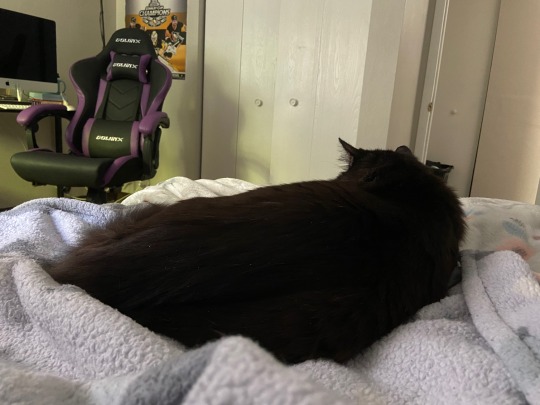
arctic woolly bear caterpillar // rider thee cat
5 notes
·
View notes
Text
Jazzy Animal Stuff
A group of platypuses is called a paddle.
When referring to multiple platypuses, you can also say platypus, platypi, or platypods.
Since platypuses are such weird creatures, people originally assumed platypuses sweat milk. (They do not)
Platypuses have a poisonous gland which means they can be venomous.
pigeons have a special feather that makes a funky noise when they fly, to alert other pigeons of possible danger nearby.
there are blue bees called blue carpenter bees. The honey they make is a similar consistency to peanut butter. They live alone and aren't very aggressive. They don't make wax
Bees dance to communicate
Bees breath through their skin and drown in the rain.
Bees fight invading wasps, not by stinging them, but by aggressively hugging them until they overheat.
Beehives are usually made facing east so they can get the sun to warm them up in the morning.
Female bees get rid of male bees by starving them and dragging them out of the hive while beating them.
Female bees kill drunk male bees
Bumble bees live in the ground
rosy maple moths don't have mouths, and the adults die in a matter of days. The larvae have a venomous sting!
Comet moths have a mouth and guts, but neither work so they only survive for a week.
The Arctic woolly bear moth is the longest living moth, and can live for up to 7 years in the wild.
Luna moths have scales on their wings that reflect light
rabbits are not rodents, but lagomorphs.
They don't have toe beans, so if you shave their feet their basically just walking on bone. Don't shave rabbit feet
snub noses monkeys sneeze in the rain due to their upturned noses.
Luna moth caterpillars deter predators by making clicking noises and regurgitating a gross fluid as a warning.
The North America Walnut Sphinx caterpillar can scream at a volume of 80 decibels.
jellyfish are the longest living multicellular organasim on earth.
ferrets like to be swung. I wrote this last year, I'm not quite sure what this means.
the babies are born so young they don't even have fully formed faces.
They are absolutely miniscule, and the only real feature they have are claws to cling onto the mother's nippels for milk.
Around 30-40 of them are born at the same time, but only 4 of them survive. The mother eats the babies that die off at the beginning.
They got their name from their ears, which go bright red.
cats mimic the sounds of their prey sometimes, like chirping at birds when they're trying to hunt them.
snails can sleep for up to 3 years.
giraffes have the same amount of vertebrae as humans.
horse stomachs are the same size as a football and their stomachs can explode if they eat too much.
Horses die really easily. This can be from lying down for too long (their lungs collapse) running for too long (heart faliure) breaking a leg (you have to kill them if this happens).
Horses sleep standing.
Horses have an almost 360° field of vision.
Horses are just really weird. My friends wonder why I'm scared of horses, but the face of a medium sized horse is like. A third of my dad. Ans my dad is t a l l.
pika's are not rodents, but lagomorphs, which make them more closely related to rabbits then mice.
They are also known as 'screaming hares' since they make a screaming noise.
Also I'm like. 90% sure pikachu was based off of a pika so. Say hi to your cousin pichaku.
seagulls can feel grief, happiness and guilt.
There is a small claw halfway up their lower leg that let's them sit on high ledges without falling off.
Both seagull parents take care of their eggs.
Seagulls can drink both fresh and salt water.
There are around 50 types of Seagulls.
Seagulls are extremely smart.
I love seagulls.
#guess what my hyperfixation in 2022 was lmao#adhd rambling#animals#animal facts#platypuses#platypods#rabbit#rabbits#seagulls#horse#horses#tasmanian devil#jellyfish#ferret#moths#luna moths#bees#i want the bee peanut butter#no i dont
0 notes
Text
Bison are being introduced to the Russian Arctic to replace extinct woolly mammoths. But why?

Scientists have introduced bison to the Russian Arctic to take on the role of extinct mammoths and help restore ancient ecosystems.
Twelve plains bison (Bison bison bison) have arrived at Ingilor Nature Park, a protected area covering more than 2.2 million acres (900,000 hectares) in the northern Yamal-Nenets Autonomous Area. The animals traveled 5,000 miles (8,000 kilometers) from a nursery in Denmark and disembarked from their long journey three weeks ago, according to a statement. Before they can discover their new home, however, the bison — also known as buffalos — must first complete a one-month quarantine.
"Buffalo can easily adapt to the Arctic because, historically, it is their natural habitat," the Yamal-Nenets Autonomous Area Department of Natural Resources and the Environment said in a separate statement. "They can take on the role of mammoths, which became extinct 11,000 years ago."
Steppe bison and woolly mammoths roamed the Russian Arctic during the late Pleistocene epoch (2.6 million to 11,700 years ago). Though a small population of disastrously damaged mammoths survived on an island off Alaska until about 4,000 years ago, most of these herbivores died out at the end of the ice age, when the climate became warmer and the grassy plains gave way to shrubs and trees.
Related: Woolly mammoths were seasonal sex fiends just like elephants, study finds
"The Pleistocene ecosystem was treeless and had quite thick soils," Mary Edwards, an emerita professor of physical geography at the University of Southampton in the U.K., told Live Science. "What you can see in geological sections of these kinds of landscapes is that, over time, they're storing soil carbon — it's frozen by the permafrost and it's basically a big carbon stack."
The animals that lumbered across these frigid plains contributed to shaping the landscape by grazing and recycling nutrients. "It's a nice cycle of animal dung fertilizing the ground and allowing the plants to grow," Edwards said. "The thought is that the animals created the ecosystem."
A 'very interesting idea'
Now, in a bid to restore this Pleistocene landscape and its ability to soak up carbon, scientists are introducing large herbivores, such as plains bison, to different parts of the Arctic.
Nikita Zimov, the director of a restoration project called Pleistocene Park in Yakutia, has been bringing bison over from Denmark since 2019. "For our rewilding efforts we are bringing to the Arctic animals which either lived here during the ice age or those who could live here in the modern climate," he told Live Science in an email.
Woolly mammoths roamed the Arctic tundra during the late Pleistocene before going extinct. (Image credit: MARK GARLICK/SCIENCE PHOTO LIBRARY via Getty Images)
This year, Zimov bought a herd of 24 bison, half of which he gave to Ingilor Nature Park in exchange for 14 musk oxen (Ovibos moschatus). These musk oxen almost went extinct in the early 1900s, and only a few scattered herds remain in the Russian Arctic, he said.
With the musk oxen now en route to Pleistocene Park, Zimov said he "aims to restore high productive grazing ecosystems in the Arctic, and through various ecological mechanisms mitigate climate change."
But Edwards is skeptical. Animals can transform ecosystems locally, she said, but the climate during the Pleistocene was probably more important in shaping the landscape. "It was too cold and too dry for trees and shrubs to grow, so you had grasses and different kinds of herbs covering the landscape," she said.
RELATED STORIES
—Scientists want to clone an extinct bison unearthed from Siberian permafrost. Experts are skeptical.
—Siberian cave filled with mammoth, rhino and bear bones is ancient hyena lair
—Woolly mammoths weren't always shaggy. Here's when they evolved some of their trademark features.
Today's climate is much warmer and wetter, meaning the ecosystem may not be suitable for large herbivores. "You have to change the landscape for them and create pastures," Edwards said.
But modifying the landscape could have unintended consequences. Thawing permafrost means there is more water in the soil, which shrubs and trees take up. "If you got rid of all the shrubs everything would get waterlogged," Edwards said, adding that this stagnant water could contribute to thaw and enhance the loss of carbon from soils.
However, introducing these animals to the Russian Arctic is "a very interesting idea," Edwards said. "There's definitely a window for the reintroduction of some of the big, lost animals of the Pleistocene."
Read the full article
0 notes
Text
yin is an arctic woolly bear moth
source: just trust us
#for the unaware this species of moth can spend up to 7 years as caterpillars#this is just a what if she wasn't messed up and her species is just. like that
1 note
·
View note
Text

Arctic Woolly Bear Moth (Gynaephora groenlandica) as Animal Teacher
Keywords: Slow down or stop completely. Freeze and thaw cycles. Consider pausing your project to gain resources in the meantime. Do not act prematurely. Hardiness. Invisible strength. Ice magic. Wind magic. Willow magic. There is strength in stopping. Dormancy. Basking in the sun. Sun friendship. Understanding your personal relationship to the seasons. A unique path. You don’t get things done like everyone else does, and that’s okay. The journey is everything. Your environment isn’t giving you enough, adapt and slow down. Make yourself a safe place.
42 notes
·
View notes
Photo

My Arctic Woolly Bear moth (Gynaephora groenlandica) is finally finished! This is the first moth that I've selfishly made for myself, purely for pleasure, no project in mind. It's a luxurious feeling ❄️✨
#art#arcticmoth#watercolor#winter#papercraft#nature#arctic#moth#arctic woolly bear#arctic moth#moths#dark#paper moth#Gynaephora groenlandica
15 notes
·
View notes
Text
TWA pygmy people were the first settlers of Ireland. The TWA wore a Uraeus, a particular hat showing a snake image which is also found on the heads of the images of the Kings and Queens of ancient Egypt. Thus St. Patrick is apparently celebrated by the Catholic Church for his work in the mass slaughter of the TWA throughout Northern Ireland.
Scottish historian David Mac Ritchie, and the British antiquarian Godfrey Higgins, have done exhaustive research and brought many facts to our knowledge. Tacitus, Pliny, Claudian and other writers have described the Blacks they encountered in the British Isles as “Black as Ethiopians,” “Cum Nigris Gentibus,” “nimble-footed blackamoors,” and so on. From all indications, the ancient dwellers of the British Isles and Ireland, like the Kymry (one of the names given to the earliest inhabitants, from whom the Picts and Scots descended), were Blacks. David Mac Ritchie has provided substantial evidence in his two-volume work, Ancient and Modern Britons that the Picts, as well as the ancient Danes, were Blacks. The Partholans, Formorians, Nemeds, Firbolgs, Tuatha De Danann, Milesians of Ireland and the Picts of Northern Scotland were all Blacks. The Firbolgs (believed to be a section of the Nemeds) are believed to be so-called pygmies or the Twa. They are the dwarfs, dark elves or leprechauns in Irish History. St. Patrick's Day, which is celebrated worldwide on March 17, honors St. Patrick, the Christian missionary who supposedly rid Ireland of snakes during the fifth century A.D.
According to legend, the patron saint of Ireland chased the slithering reptiles into the sea after they began attacking him during a 40-day fast he undertook on top of a hill. But snakes were certainly not chased out of Ireland by St. Patrick, who had nothing to do with Ireland's snake-free status. Why would a man be canonized {declared to be a saint} just because he supposedly got rid of all the snakes in Ireland? Monaghan, who has trawled through vast collections of fossil and other records of Irish animals, has found no evidence of snakes ever existing in Ireland. "At no time has there ever been any suggestion of snakes in Ireland.
[There was] nothing for St. Patrick to banish," Monaghan said. Snakes likely couldn't reach Ireland. Most scientists point to the most recent Ice Age, which kept the island too cold for reptiles until it ended 10,000 years ago. After the Ice Age, surrounding seas may have kept snakes from colonizing the Emerald Isle. Once the ice caps and woolly mammoths retreated northward, snakes returned to northern and western Europe, spreading as far as the Arctic Circle. But snakes have not existed in Ireland for thousands of years.
Britain, which had a land bridge to mainland Europe until about 6,500 years ago, was colonized by three snake species: the venomous adder, the grass snake, and the smooth snake.Animals that reached Ireland before the sea became an impassable barrier included brown bears, wild boars, and lynx—but "snakes never made it," he said. "Snake populations are slow to colonize new areas," Monaghan added.Mark Ryan, director of the Louisiana Poison Center at the Louisiana State University Health Sciences Center in Shreveport, said in 2008 that the timing wasn't right for the sensitive, cold-blooded reptiles to expand their range. "There are no snakes in Ireland for the simple reason they couldn't get there because the climate wasn't favorable for them to be there," he said. Other reptiles didn't make it either, except for one: the common or viviparous lizard.
Ireland's only native reptile, the species must have arrived within the last 10,000 years, according to Monaghan. The Twa journeyed to Northern Ireland very early in its conception prior to the influence of the Roman Catholic Church & had a cultural, technological, & philosophical impact on a people there known as the Druids. One of the cultural influences the Druids got from the Twa was the fact that they wore a fez or head cover that depicted the African symbol known is a Uraeus, which is the same snake image you see worn by the Kings & Queens in ancient Kemet {Egypt}. To Twa, some of the names for our people include; Naga, Nagar and Negus, which means loosely “serpent people” or “people of the serpent”. The name is also synonymous with Pharaohs and Kings. In many African cultures, the serpent is not a symbol of evil but one of eternal life, regeneration, power, protection, and wisdom.
The existence of the TWA also is reflected in many of the Irish legends that were passed down by the Druids to contemporary times. The story of the Leprechaun or a type of fairy that dressed in a green coat and who saved cold coins in a pot is a reflection of the diminutive people who were craftsmen in their time. It was said they had special knowledge of medicine, metallurgy, textile, and shoe-making which the Caucasians perceived as “magical.” The Roman Catholic Church seeing the practices of the Druids wanted to convert them, and if they couldn't, the would remove them & their beliefs as well along with the Twa who were still present in Northern Ireland at that time. St Patrick under the direction of Patrick who acted on behalf of the Catholic Church.
Author David MacRitchie, in his book Ancient and Modern Britons, wrote: “that the wild tribes of Ireland were black men is hinted by the fact that ‘a wild Irishman’ is in Gaelic ‘a black Irishman (Dubh Eireannach).” The word Dubh in Gaelic means Black. Was given an order to set up Roman Catholic Churches all over Northern Ireland, and in the process, convert or remove the Druid & Twa influence. He killed countless numbers of Druids & the Twa in the name of Father, the Son, & the Holy Spirit.
He was made a saint because he removed the snakes from Northern Ireland, it's really referring to the Uraeus head garment worn by the Druids & the Twa. And the leprechaun myth comes from the short Black men that were murdered all in the name of religion.

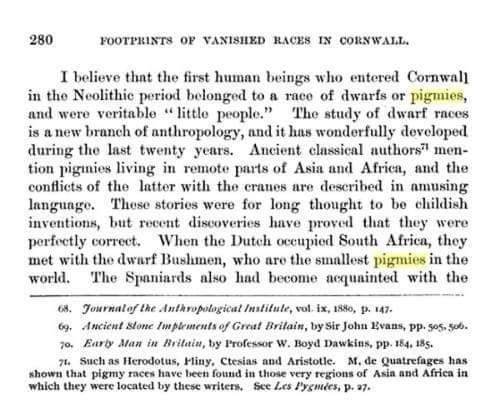

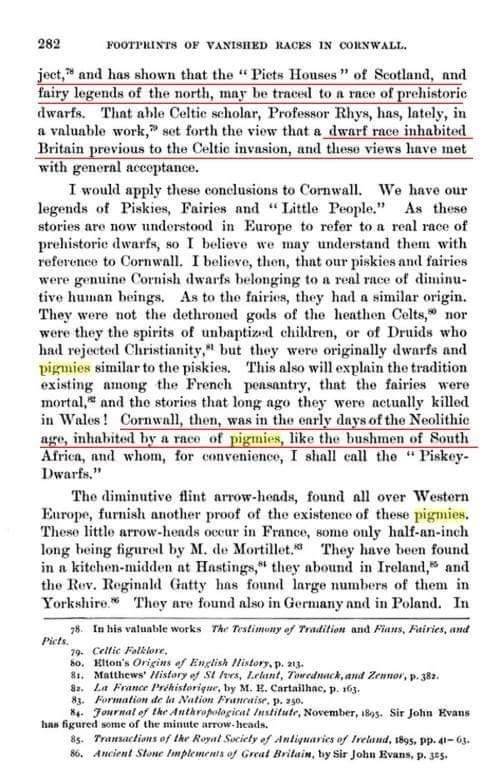
21 notes
·
View notes
Note
how long do moths live for
A typical moth lives up to 1-2 weeks once it reaches adulthood! But some moths like the Arctic woolly bear moth, can live for a few years!!!
15 notes
·
View notes
Text




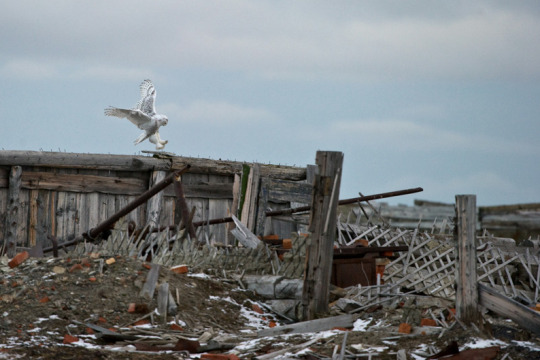

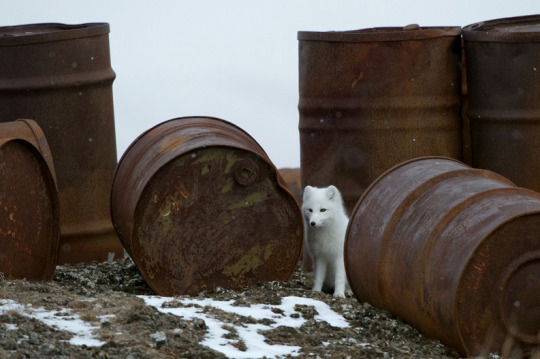
Derelict infrastructure on Wrangel Island.
Snowy owl. Arctic fox. Polar bear.
Photos by Sergei Gorzhkov. Circulated in media in 2010.
Home to woolly mammoths only 4000 years ago (centuries after the construction of the Great Pyramids of Egypt.) Now a UNESCO site and home to many lemmings.

239 notes
·
View notes